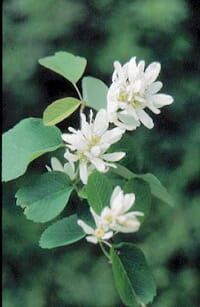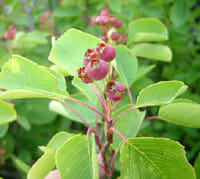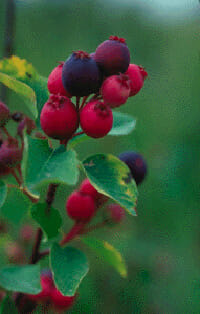Saskatoon Berry – Rosales Rosaceae Amelachier alnifolia
 |
 |
 |
Identification & Description:
A decidious shrub growing to 4m by 3m . It is hardy to zone 2 and is not frost tender. It is in flower in May, and the seeds ripen from June to July. The flowers are hermaphrodite (have both male and female organs) and are pollinated by Bees. The plant is self-fertile. We rate it 5 out of 5 for usefulness.
The plant prefers light (sandy), medium (loamy) and heavy (clay) soils and can grow in heavy clay soil. The plant prefers acid, neutral and basic (alkaline) soils. It can grow in semi-shade (light woodland) or no shade. It requires moist soil.
The edible fruit is similar in size and shape to a blueberry, but tastes like a blueberry with an injection of almond extract. Saskatoons, when ripe, are a very dark purple, almost black.
Native Canadians and Americans used Saskatoons in making pemmican, a staple food for hunting parties. Homesteaders and farmers have long used the Saskatoon berry for making fruit preserves and pies.
Today our uses for the berries are only limited by our imaginations.
Habitats and Possible Locations
Woodland, Sunny Edge, Dappled Shade.
Cultivar ‘Northline’: Woodland, Sunny Edge, Dappled Shade.
Cultivar ‘Timm’: Woodland, Sunny Edge, Dappled Shade.
Cultivar ‘Thiessen’: Woodland, Sunny Edge, Dappled Shade.
Cultivar ‘Smoky’: Woodland, Sunny Edge, Dappled Shade.
Cultivar ‘Honeywood’: Woodland, Sunny Edge, Dappled Shade.
Cultivar ‘Gypsy’: Woodland, Sunny Edge, Dappled Shade.
Cultivar ‘Forestburg’: Woodland, Sunny Edge, Dappled Shade.
Cultivar ‘Beaverlodge’: Woodland, Sunny Edge, Dappled Shade.
Cultivar ‘Pembina’: Woodland, Sunny Edge, Dappled Shade.
Edible Uses
Fruit; Tea.
Edible fruit – raw or cooked. The fruit ripens in mid summer (early July in southern Britain), it is soft and juicy with a few small seeds in the centre. A very nice sweet flavour that is enjoyed by almost everyone who tries it, there is a hint of apple in the taste. About the size of a blackcurrant, the fruit is produced in small clusters and the best wild forms can be 15mm in diameter. The fruit can also be dried and used as raisins or made into pemmican. The fruit is rich in iron and copper.
The leaves are a tea substitute.
Saskatoon berries are often found in dry woods and on open hillsides in dry soil. The Secwepemc ate the berries fresh or they would dry them into cakes to eat at later date.
In some areas of the Secwepemc territory a “First Fruits” ceremony was held to celebrate the beginning of the saskatoon-picking season.